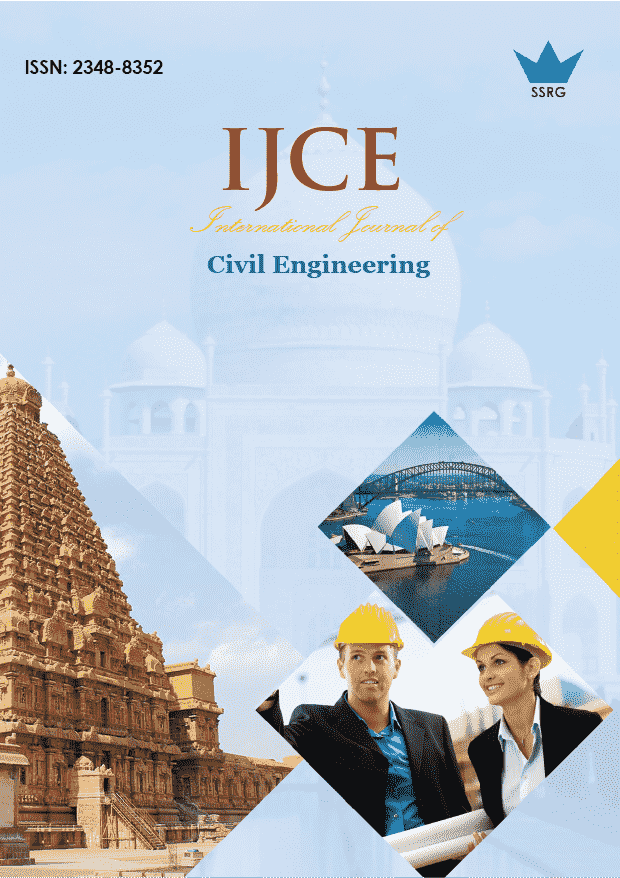The Assessment of the Physiochemical Treatment Systems for Confectionary Industrial Wastewater

| International Journal of Civil Engineering |
| © 2025 by SSRG - IJCE Journal |
| Volume 12 Issue 3 |
| Year of Publication : 2025 |
| Authors : Omama Ahmed Hussein KAMALELDIN, Mohamed ElHosseiny EL-NADI, Mahmoud Mohammed ABDELMOMEN, Amira Mohamed NAGY |
How to Cite?
Omama Ahmed Hussein KAMALELDIN, Mohamed ElHosseiny EL-NADI, Mahmoud Mohammed ABDELMOMEN, Amira Mohamed NAGY, "The Assessment of the Physiochemical Treatment Systems for Confectionary Industrial Wastewater," SSRG International Journal of Civil Engineering, vol. 12, no. 3, pp. 30-39, 2025. Crossref, https://doi.org/10.14445/23488352/IJCE-V12I3P103
Abstract:
This study presents a comparative analysis of three physicochemical treatment units-Chemical Enhanced Sedimentation, Chemical Enhanced Flotation, and Chemical Enhanced Sand Filtration-designed for treating the highly polluted effluent from a sweets factory in the industrial zone of Cairo, Egypt. This effluent, characterized by high concentrations of sugars, organics, and suspended solids, poses significant challenges for meeting stringent national wastewater discharge standards. The treatment units were systematically evaluated using FeCl₃ at an optimal dose of 160 ppm, determined through jar testing of the target wastewater. The units were scaled to reflect the capacities of actual factory installations, ensuring practical relevance. Their performance was assessed based on the removal efficiencies of Total Dissolved Solids (TDS), Total Suspended Solids (TSS), and Chemical Oxygen Demand (COD). Among the tested units, the Chemical Enhanced Sand Filtration unit demonstrated superior performance, achieving removal efficiencies of 90.7% for TDS, 31.2% for TSS, and 61.1% for COD. These results position the Sand Filtration unit as a promising solution for confectionery wastewater treatment, enabling compliance with environmental regulations and supporting potential water reuse applications such as cleaning, cooling, or irrigation. The findings offer a practical framework for similar industries seeking sustainable and efficient wastewater management solutions.
Keywords:
Chemical filtration, Chemical flotation, Chemical sedimentation, Sweets industry, Sweets industry sewage.
References:
[1] Yi Jing Chan et al., “A Review on Anaerobic–Aerobic Treatment of Industrial and Municipal Wastewater,” Chemical Engineering Journal, vol. 155, no. 1-2, pp. 1-18, 2009.
[CrossRef] [Google Scholar] [Publisher Link]
[2] Swapnila Roy et al., Advanced Industrial Wastewater Treatment and Reclamation of Water: Comparative Study of Water Pollution Index during Pre-Industrial, Industrial Period and Prospect of Wastewater Treatment for Water Resource Conservation, 1st ed., Springer Cham, 2022.
[CrossRef] [Google Scholar] [Publisher Link]
[3] Waterborne Diseases, UNDRR, 2012. [Online]. Available: https://www.undrr.org/understanding-disaster-risk/terminology/hips/bi0018
[4] Clean Water Act, United States Environmental Protection Agency, 2024. [Online]. Available: https://www.epa.gov/laws-regulations/summary-clean-water-act
[5] Susanne M. Scheierling et al., “Towards an Agenda for Improving Wastewater Use in Agriculture,” Water International, vol. 36, no. 4, pp. 420-440, 2011.
[CrossRef] [Google Scholar] [Publisher Link]
[6] H. Ozgun et al., “Confectionery Industry: A Case Study on Treatability-Based Effluent Characterization and Treatment System Performance,” Water Science & Technology, vol. 66, no. 1, pp. 15-20, 2012.
[CrossRef] [Google Scholar] [Publisher Link]
[7] Self-Monitoring Manual: Confectionary Industry, Ministry of State for Environmental Affairs, pp. 1-86, 2003. [Online]. Available: https://www.eeaa.gov.eg/Uploads/Project/Files/20221229120059108.pdf
[8] Article 14, Environment Protection Fund, Ministry of State for Environmental Affairs, 2009. [Online]. Available: https://www.eeaa.gov.eg/Uploads/Laws/Files/20221010120915151.doc
[9] Fayza A. Nasr, Ibrahim Abdelfattah, and Saber A. El-Shafai, “Cost Effective Management of Confectionery Industrial Wastewater,” Egyptian Journal of Chemistry, vol. 65, no. 5, pp. 391-399, 2022.
[CrossRef] [Google Scholar] [Publisher Link]
[10] Guzine El Diwani et al., “Treatment of Confectionery and Gum Factory Wastewater Effluent,” Adsorption Science & Technology, vol. 18, no. 9, pp. 813-821, 2000.
[CrossRef] [Google Scholar] [Publisher Link]
[11] A.P. Vanerkar, Sanjeev Satyanarayan, and Shanta Satyanarayan, “Treatment of Food Processing Industry Wastewater by a Coagulation/ Flocculation Process,” International Journal of Chemical and Physical Sciences, vol. 2, pp. 63-72, 2013.
[Google Scholar] [Publisher Link]
[12] Lara J. Beal, and D. Raj Raman, “Sequential Two-stage Anaerobic Treatment of Confectionery Wastewater,” Journal of Agricultural Engineering Research, vol. 76, no. 2, pp. 211-217, 2000.
[CrossRef] [Google Scholar] [Publisher Link]
[13] Vinod R. Bhagwat, Chapter 9 - Safety of Water Used in Food Production, Food Safety and Human Health, pp. 219-247, 2019.
[CrossRef] [Google Scholar] [Publisher Link]
[14] Vaibhav Shrivastava et al., “Wastewater in the Food Industry: Treatment Technologies and Reuse Potential,” Chemosphere, vol. 293, 2022.
[CrossRef] [Google Scholar] [Publisher Link]
[15] UNESCO, “The United Nations World Water Development Report 2017, Wastewater: The Untapped Resource,” United Nations Educational, Scientific and Cultural Organization, Report, pp. 1-198, 2017.
[Google Scholar] [Publisher Link]
[16] Md. Nahid Pervez et al., “Sustainable Treatment of Food Industry Wastewater Using Membrane Technology: A Short Review,” Water, vol. 13, no. 23, pp. 1-18, 2021.
[CrossRef] [Google Scholar] [Publisher Link]
[17] S.J. Haig et al., “Biological Aspects of Slow Sand Filtration: Past, Present and Future,” Water Supply, vol. 11, no. 4, pp. 468-472, 2011.
[CrossRef] [Google Scholar] [Publisher Link]
[18] András József Tóth et al., “Physicochemical Methods for Process Wastewater Treatment: Powerful Tools for Circular Economy in the Chemical Industry,” Reviews in Chemical Engineering, vol. 39, no. 7, pp. 1123-1151, 2023.
[CrossRef] [Google Scholar] [Publisher Link]
[19] Arcadio Pacquiao Sincero, and Gregoria Alivio Sincero, Environmental Engineering: A Design Approach, Prentice Hall, pp. 1-795, 1996.
[Google Scholar] [Publisher Link]
[20] George Tchobanoglous, Franklin Louis Burton, and H. David Stensel, Wastewater Engineering: Treatment and Reuse, McGraw-Hill Education, pp. 1-1819, 2003.
[Google Scholar] [Publisher Link]
[21] American Public Health Association, Standard Methods for the Examination of Water and Wastewater, American Public Health Association, pp. 1-26, 2017.
[Google Scholar] [Publisher Link]

 10.14445/23488352/IJCE-V12I3P103
10.14445/23488352/IJCE-V12I3P103